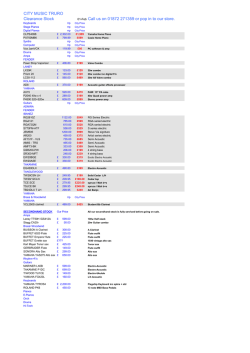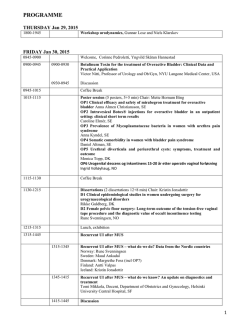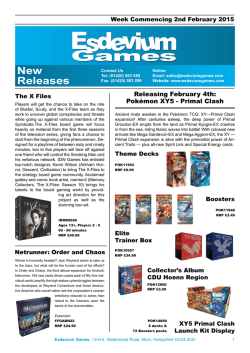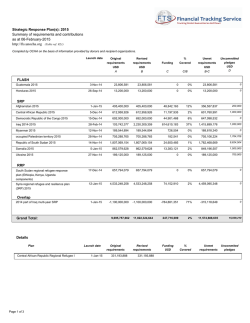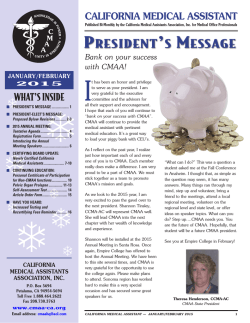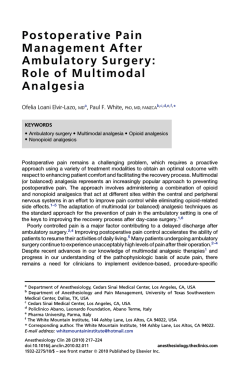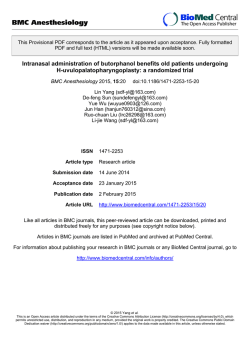
Summary of oral presentation by Dr. Karsch
Summary of oral presentation by Dr. Karsch, Loretto-‐Krankenhaus Freiburg, at SWDGU Congress, Friedrichshafen 2015 Influence of 4DryField® on the incidence of lymphoceles after pelvic lymphadenectomy for radical retropubic prostatovesiculectomy Karsch, J., Berthold, M., Breul, J.; Loretto-‐Krankenhaus, Urology, Freiburg, Germany Aim: The incidence of lymphoceles (LC) after retropubic prostatovesiculectomy (RRP) ranges from 5-‐11% according to literature1; 2. LC that require therapy are quite rare, but may be associated with severe impairment and follow-‐up surgery. The present pilot study investigates to what extent 4DryField® 3 (4DF), certified hemostasis and adhesion prevention, influences lymphorrhoe and formation of symptomatic LC. Method: From June 2013 to July 2014 a total of 104 patients had RRP including bilateral pelvic lymphadenectomy. Tabotamp® (Ethicon) was introduced into the Fossa obturatoria on both sides and a drain was placed in the right lower abdomen for 3-‐5 days in all cases (control [CT] group, n=51). In 53 patients, additionally a total of 5 g 4DF was administered to the area of the iliacal vessels and Fossa obturatoria on both sides (4DF group, n=53). Sonographic controls were performed postoperatively on days 5 and 8. Furthermore, the status was surveyed by the release reports of the rehabilitation clinic after 6-‐8 weeks. Telephone consultation was conducted (in the median 7 months postoperatively) for revealing LC, which necessitated intervention in long-‐term course. Results: The average number of removed lymph nodes (CT: 18, 4DF: 17) was comparable in both groups. There was a somewhat reduced drain loss in the 4DF group as compared to CT (308.5 vs. 452.5 ml, n.s.) .In the CT group there were 5 outliers with drain loss >1000 ml (1100-‐3300 ml), where as there was none in the 4DF group (p<0.05). Within the 1st week, 10 LC developed in CT and 11 LC in the 4DF group (n.s.). In later postoperative controls the number of LC was twice as high in the CT group (16 LC) as compared to the 4DF group (8 LC). Accordingly, concerning LC requiring intervention (i.e. volume >100 ml) there were 4 patients in the CT and 2 in the 4DF group. Importantly, the mean treatment duration (time of drainage of LC) was 44.5 days in CT and only 12 days in 4DF patients (p<0.05) . A marsupialization was not necessary in any case. Discussion: With 4DF treatment a somewhat reduction of drain loss was noticeable, but needs to be substantiated in larger cohorts. However, with 4DF treatment incidences with excessive drain loss (>1000 mL) were significantly lower as compared to CT patients. This indicates that 4DF application after RRP with extensive lymph adenectomy might have a favourable impact on postoperative loss of wound secretion and/or lymph. Interestingly, in the later course the incidence of LC was significantly lower in 4DF patients as compared to CT, corresponding with lower rate of intervention. Importantly, in cases with LC necessitating intervention the duration of treatment in 4DF patients was significantly shorter. Summary: Application of 4DF in patients with RRP and pelvic lymphadenectomy has a favourable impact on the postoperative wound secretion and/or lymph loss associated with a reduced incidence of lymphoceles. These results are promising and should be validated in prospective randomized studies. 1 Bauer JJ, McLeod DG (1998) Hepatic subcapsular extension of pelvic lymphocele after radical retropubic prostatectomy. Urology 51: 846-‐848 2 Noldus J, Hammerer P, Graefen M, Huland H (1997) Surgical therapy for localized prostatic carcinoma. J Cancer Res Clin Oncol 123: 180-‐184 3 4DryField® PH, PlantTec Medical GmbH, Bad Bevensen, Deutschland
© Copyright 2026
